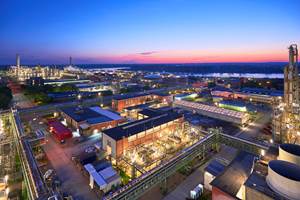Plastics Growth in Building & Construction Driven by Innovation, Market Demand
SPI’s new report analyzes the key factors impacting the plastic industry in the building and construction sector.
SPI’s new report analyzes the key factors impacting the plastic industry in the building and construction sector.
At last week’s 2016 International Builders’ Show in Las Vegas, SPI released its newest report, “Plastics Market Watch: Building and Construction”, the fourth in a series published by SPI analyzing key factors impacting the plastics industry’s major end markets. Already the second largest consumer of plastics behind only packaging, building and construction’s use of plastics and plastics derivatives is forecast continue to increase in coming years.
“From floors to roofs, inside and outside of walls, plastics are a go-to product on construction sites,” SPI President and CEO William Carteaux said. “Innovation in the plastics industry to improve and diversify products is matched by the building and construction sector’s pace to find, and use, new solutions to address fundamental issues like structural integrity, energy savings, recycling, and cost saving.”
The leading uses of plastics for residential and commercial construction include roofing, insulation, wall coverings, windows, piping, composite lumber, flooring and structure wraps. Further details as noted in the report are:
• Roofing—Reflective, light-colored roofing membranes made of PVC or TPO single-ply membranes combined with rigid polyiso board or spray polyurethane foam—offer energy savings, durability and moisture control, especially for commercial buildings in warmer/wetter climates. Studies show that the surface temperature of a light covered roof is much lower than a darker one. The cooler the building, the less air conditioning is required, and therefore, the less energy is consumed.
• Insulation—Whether it is spray polyurethane foam (SPF) in the attic or rigid foam polyiso board in the walls, polyurethane-based systems offer durability, energy savings and moisture control. When used for retrofits, they also help reduce the amount of building waste sent to landfills. In walls, behind walls and under floors, the use of polystyrene foams can provide significant energy efficiency. For example, rigid extruded polystyrene (XPS) is a builder favorite because it can be installed easily and effectively. Structural insulated panels (SIPs) made with expanded polystyrene (EPS) can help homeowners save hundreds of dollars annually on heating and cooling bills. The report notes that savings vary by material and products.
• Wall Coverings—Vinyl-based materials are commonly used for durable, easy-to-clean hospitality and health-care facilities. Vinyl requires only half as much energy to manufacture as the same amount of paper wall coverings.
• Windows—Polycarbonate is used for window panes. These clear, lightweight, shatter-resistant PC products have low thermal conductivity which can help reduce heating and cooling costs. PVC window frames are inherently energy efficient and save the U.S. nearly two trillion thermal units of energy per year, helping reduce greenhouse gas emissions, associated with energy generation—and at the same time reducing maintenance time, materials and other costs.
• Piping—Plastics pipe and fittings are relatively easy to install, durable and will not rust or corrode over time. Several types of plastics are used for piping depending on the properties and performance required. Whether PE, PP, PVC, or ABS, they each offer excellent fusion integrity when joined properly, in turn helping to eliminate potential leak points where water could be wasted. In home building flexible blue and red cross-linked PE piping (PEX) has become a favorite of many builders for hot and cold water delivery, all managed and hooked into a central and effective manifold system. The flexibility, lightness and ease of installation allow multiple feed lines throughout a house, bringing hot water more quickly to a sink or shower and saving water.
• Composite “lumber” planks and rails—Recycled plastics or plastic-wood composites are carefully engineered to virtually eliminate warpage and knots, with PVC, HDPE, and PP among the plastics used. They can outlast traditional materials, often require less maintenance and are resistant to peeling, cracking, splintering or fading. They are also eco-friendly in that much of the lumber is made from recycled materials and/or can itself be recycled.
• Plastic House Wrap—This technology (polyolefins and PVC play a role) has reduced the infiltration of outside air into the average home by 10-50% helping to drastically reduce the energy required to heat or cool a structure. Estimates conclude that these plastic films have helped reduce greenhouse gas emissions in the U.S. by as much as 120-600 million tons of CO2 since 1980.
Advances in plastics have been embraced by architects, engineers and designers. As proof, SPI cites a report from a Columbia University conference: “Permanent Change: Plastics in Architecture and Engineering”
Plastics have become one of the most ubiquitous and increasingly permanent materials in construction. The material capabilities of plastics, both as a generic material and as specific polymers, and the processes that underlie them, suggest a potential to reshape construction and the roles of architects and engineers in construction. While plastics are perhaps the most intensively engineered building materials today, we are still in the early stages of understanding them in terms of their potential applications and uses.
SPI will continue its Plastics Market Watch reports later this year, with “Automotive Recycling” to be published before end of this quarter. The three previous reports, including “Automotive & Transportation”, “Healthcare & Medical Devices”, and “Packaging” are available on the SPI website.
Image courtesy BASF

Related Content
Ineos Nitriles Launches Biobased Acrylonitrile
The company’s Invireo is said to deliver a 90% lower carbon footprint compared to conventionally produced acrylonitrile.
Read MoreInfrastructure May Prove Big Landing Spot for Recycled Plastics
As the government funds infrastructure improvements, a hot topic at NPE2024 – exploration of the role recycled plastics can play in upcoming projects, particularly road development.
Read MoreNova Makes Senior Leadership Changes
The company’s aim is to bolster sustainability ambitions
Read MorePackaging Waste Will Become Composite Decking
New partnership will incorporate process waste into wood-alternative decking.
Read MoreRead Next
Advanced Recycling: Beyond Pyrolysis
Consumer-product brand owners increasingly see advanced chemical recycling as a necessary complement to mechanical recycling if they are to meet ambitious goals for a circular economy in the next decade. Dozens of technology providers are developing new technologies to overcome the limitations of existing pyrolysis methods and to commercialize various alternative approaches to chemical recycling of plastics.
Read MoreLead the Conversation, Change the Conversation
Coverage of single-use plastics can be both misleading and demoralizing. Here are 10 tips for changing the perception of the plastics industry at your company and in your community.
Read MoreTroubleshooting Screw and Barrel Wear in Extrusion
Extruder screws and barrels will wear over time. If you are seeing a reduction in specific rate and higher discharge temperatures, wear is the likely culprit.
Read More











 (2).jpg;maxWidth=300;quality=90)














